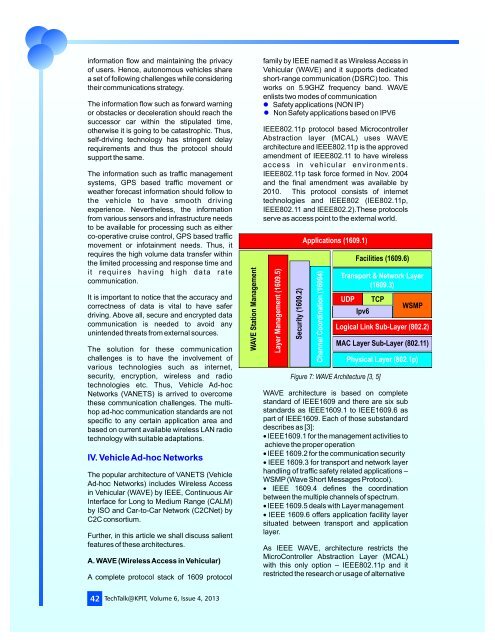Autonomous Vehicles - KPIT
Autonomous Vehicles - KPIT
Autonomous Vehicles - KPIT
Create successful ePaper yourself
Turn your PDF publications into a flip-book with our unique Google optimized e-Paper software.
information flow and maintaining the privacy<br />
of users. Hence, autonomous vehicles share<br />
a set of following challenges while considering<br />
their communications strategy.<br />
The information flow such as forward warning<br />
or obstacles or deceleration should reach the<br />
successor car within the stipulated time,<br />
otherwise it is going to be catastrophic. Thus,<br />
self-driving technology has stringent delay<br />
requirements and thus the protocol should<br />
support the same.<br />
The information such as traffic management<br />
systems, GPS based traffic movement or<br />
weather forecast information should follow to<br />
the vehicle to have smooth driving<br />
experience. Nevertheless, the information<br />
from various sensors and infrastructure needs<br />
to be available for processing such as either<br />
co-operative cruise control, GPS based traffic<br />
movement or infotainment needs. Thus, it<br />
requires the high volume data transfer within<br />
the limited processing and response time and<br />
it requires having high data rate<br />
communication.<br />
It is important to notice that the accuracy and<br />
correctness of data is vital to have safer<br />
driving. Above all, secure and encrypted data<br />
communication is needed to avoid any<br />
unintended threats from external sources.<br />
The solution for these communication<br />
challenges is to have the involvement of<br />
various technologies such as internet,<br />
security, encryption, wireless and radio<br />
technologies etc. Thus, Vehicle Ad-hoc<br />
Networks (VANETS) is arrived to overcome<br />
these communication challenges. The multihop<br />
ad-hoc communication standards are not<br />
specific to any certain application area and<br />
based on current available wireless LAN radio<br />
technology with suitable adaptations.<br />
IV. Vehicle Ad-hoc Networks<br />
The popular architecture of VANETS (Vehicle<br />
Ad-hoc Networks) includes Wireless Access<br />
in Vehicular (WAVE) by IEEE, Continuous Air<br />
Interface for Long to Medium Range (CALM)<br />
by ISO and Car-to-Car Network (C2CNet) by<br />
C2C consortium.<br />
Further, in this article we shall discuss salient<br />
features of these architectures.<br />
A. WAVE (Wireless Access in Vehicular)<br />
A complete protocol stack of 1609 protocol<br />
WAVE Station Management<br />
family by IEEE named it as Wireless Access in<br />
Vehicular (WAVE) and it supports dedicated<br />
short-range communication (DSRC) too. This<br />
works on 5.9GHZ frequency band. WAVE<br />
enlists two modes of communication<br />
lSafety applications (NON IP)<br />
lNon Safety applications based on IPV6<br />
IEEE802.11p protocol based Microcontroller<br />
Abstraction layer (MCAL) uses WAVE<br />
architecture and IEEE802.11p is the approved<br />
amendment of IEEE802.11 to have wireless<br />
access in vehicular environments.<br />
IEEE802.11p task force formed in Nov. 2004<br />
and the final amendment was available by<br />
2010. This protocol consists of internet<br />
technologies and IEEE802 (IEE802.11p,<br />
IEEE802.11 and IEEE802.2).These protocols<br />
serve as access point to the external world.<br />
Layer Management (1609.5)<br />
Security (1609.2)<br />
Applications (1609.1)<br />
Channel Coordination (16094)<br />
Figure 7: WAVE Architecture [3, 5]<br />
Facilities (1609.6)<br />
Transport & Network Layer<br />
(1609.3)<br />
UDP<br />
Ipv6<br />
TCP<br />
WAVE architecture is based on complete<br />
standard of IEEE1609 and there are six sub<br />
standards as IEEE1609.1 to IEEE1609.6 as<br />
part of IEEE1609. Each of those substandard<br />
describes as [3]:<br />
•IEEE1609.1 for the management activities to<br />
achieve the proper operation<br />
•IEEE 1609.2 for the communication security<br />
•IEEE 1609.3 for transport and network layer<br />
handling of traffic safety related applications –<br />
WSMP (Wave Short Messages Protocol).<br />
•IEEE 1609.4 defines the coordination<br />
between the multiple channels of spectrum.<br />
•IEEE 1609.5 deals with Layer management<br />
•IEEE 1609.6 offers application facility layer<br />
situated between transport and application<br />
layer.<br />
As IEEE WAVE, architecture restricts the<br />
MicroController Abstraction Layer (MCAL)<br />
with this only option – IEEE802.11p and it<br />
restricted the research or usage of alternative<br />
WSMP<br />
Logical Link Sub-Layer (802.2)<br />
MAC Layer Sub-Layer (802.11)<br />
Physical Layer (802.1p)<br />
42 TechTalk@<strong>KPIT</strong>, Volume 6, Issue 4, 2013


